| |
“Overall, Crimewave was a lesson about abject failure – no matter how you slice it, the film was a dog, and everyone involved can pretty much line up to take forty whacks. As filmmakers, we failed to execute a misguided concept and our studio refused us the benefit of any doubt.” |
| |
Crimewave lead actor and producer Bruce Campbell |
The Evil Dead was one of those debut features that almost everyone who saw it and loved it on its release just knew was going to launch the careers of its young creators. And make no mistake, these people really were young when they made that little low-budget indie horror masterpiece. At the time of its completion, director Sam Raimi would have been 22, leading man Bruce Campbell 23, score composer Joseph LoDuca 23, and producer Rob Tapert the old man of the piece at 27. The only reason I’ve not listed more examples is because I’ve been unable to pinpoint the ages of many of the other contributors, but I'm guessing it's a similar story. It’s also worth remembering that The Evil Dead effectively took four years to complete and was thus begun when some of these fine people, director Raimi included, were still in their late teens. Three years after The Evil Dead, another visually arresting low-budget independent debut feature from two talented young filmmakers hit cinemas in the shape of Blood Simple, the work of brothers Joel and Ethan Coen. Once again, it seemed clear to almost all of us who saw it at the time that these two fellows were set to go places. Both Raimi and the Coens followed these calling-card first features with stylistically audacious comedies. Yet while the Coens’ Raising Arizona opened to mixed reviews but went on to make over three times its $6 million budget at the American box-office alone, Sam Raimi’s Crimewave absolutely bombed on its release, being critically panned and making back a paltry $5,101 of its estimated $3 million budget.* Which is all the more peculiar when you consider that the film was written by Raimi in collaboration with Raising Arizona screenwriters and directors Joel and Ethan Coen.**
So, what the hell went wrong? To tell the whole story would swallow up too much space here and is covered in some detail anyway in the plentiful special features on this this Blu-ray release, but here are a few key points to consider:
- The still-young filmmakers went into their first studio film with a low-budget indie mindset and really didn’t know their way around a studio production.
- The studio in question, Embassy, demanded changes from the off, rejecting Bruce Campbell as a leading man and insisting on the hiring of Los Angeles actors, despite the fact that the film was shot in Detroit.
- Embassy also imposed some changes that altered the tone of the film from a blackly comic thriller to a whacky comedy.
- Despite this, the film cannot be comfortably slotted into (or indeed marketed as belonging to) a single genre, but instead takes a whole collection of them and throws them into a cinematic blender.
- When shooting was complete, a dissatisfied Embassy eventually took the editing out of Raimi’s hands and insisted on reshoots, cutting some sequences and adding wraparound scenes designed to contextualise the rest of the action.
- Unhappy with the result even after this rejig, Embassy only released the film briefly in Kansas and Alaska, the minimum big screen exposure required to qualify the film for an HBO screening.
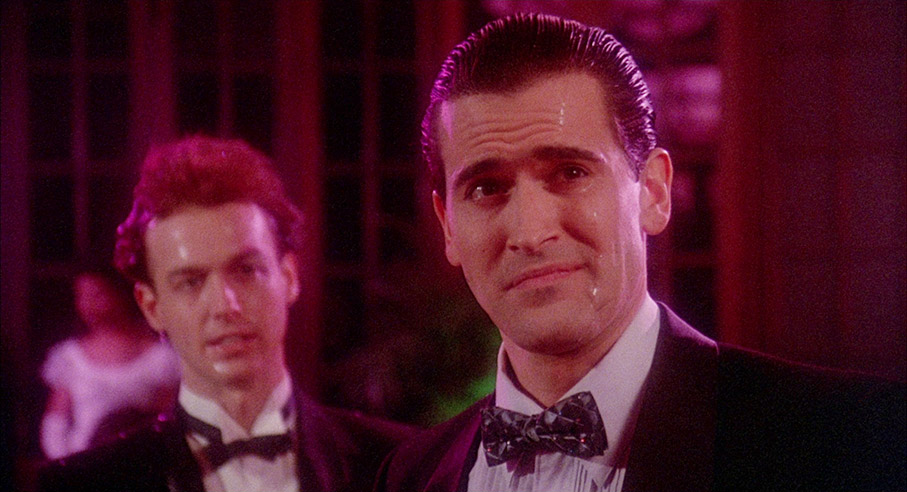
When I first saw Crimewave I knew nothing of this multitude of production problems or the fact that Raimi himself had effectively disowned the film, later describing Embassy’s decision to take the editing away from him as “the worst time of my life.”*** I thus went in knowing only that it was a new film from the director of The Evil Dead, which I had adored. I thought it was hilarious. I loved its stylised look and its refusal to settle into a single genre, and although relegated to a small supporting role (one that was beefed up a bit by Raimi from the original script as compensation for the fact that his good friend had been bumped from the lead), I laughed at just about everything Bruce Campbell did in it. I wasn’t the only one. The close friend I watched it with used to piss himself laughing at seemingly small details (I remember him cracking up at a photo one character keeps of his wife on his desk – you’ll know it when you see it), and even all these years later, another good friend and I regularly quote Campbell’s dialogue at each other during our weekly online gaming sessions. According to him (he's younger and has a more reliable memory), our shared enthusiasm for the movie came up in conversation the first time we met. Years later, I can better appreciate the problems that plagued the production, see where compromises were made and lament the fact that Campbell did not play a lead role that I’m willing to bet he’d have been marvellous in. Yet watching it again on Indicator’s Blu-ray, I still laughed out loud at many of the gags and still twitched with delight at the film’s ambition and stylistic audacity. In some ways, sure, it’s all over the place, but it’s still an inspired and joyously inventive watch, and frankly, I’ll take that over the vast majority of big-budget polished Hollywood products of the day or any day since, thank you very much.
It begins with the “what-the-hell?” image of a car packed with nuns barrelling down a city street like late arrivals to a career-changing NASCAR race, their desperation fuelled by the impending execution of one Vic Ajax (Reed Birney). As Vic is forcibly escorted to the electric chair, he desperately claims there’s been a terrible mistake and tries to explain to his disinterested guards how he ended up mistakenly facing the death penalty. His story then unfolds in flashback with his employer, Ernest Trend (Edward R. Pressman), overhearing his partner, Donald Oldegard (Hamid Dana), making secret plans to sell their home security business to a slick-haired spiv named Renaldo (Bruce Campbell), who has plans to turn it into an erotic revue bar. In an attempt to surreptitiously scupper the deal, Trend hires exterminators Faron Crush (Paul L. Smith) and Arthur Coddish (Brion James) to kill Oldegard in his office that very night. On returning to his nearby apartment, Trend encounters the still working Vic and dissuades him from going to the office by suggesting he instead take the rest of the day off and go out and find himself the girl of his dreams. Vic’s only just reached the apartment block lobby when the girl in question appears in the shape of the beautiful Nancy (Sheree J. Wilson), who is knocked off her feet outside by a van being driven by Crush and Coddish. After picking her up and getting punched in the eye by Crush for calling him a maniac, Vic clumsily attempts to ask Nancy out, an invitation that she politely and repeatedly declines. It’s then that Renaldo shows up and charms Nancy into a date, one she instantly and gleefully accepts. “Socially,” Vic observes in astonishment, “the man’s a genius.” When the date in question turns sour, however, Vic is waiting on the sidelines to step in and take Renaldo’s place, unaware of the series of disastrous misadventures that await him.
It’s worth noting that the above is just an overview of how the film’s various story threads unfold and interconnect, a trend (no character pun intended) that continues and escalates during the course of the film. A fourth such thread is added once Trend returns to his over-the-road apartment, where the nosiness of his wife Helene (Louise Lasser) results in her taking a too-keen interest in what’s going on after hours in the office she can see clearly from their window, particularly with the aid of binoculars. Her relentless inquisitiveness eventually prompts her increasingly wound-up husband to make a show of going over to the office to investigate, which lands him in hot water with the very men he has hired to kill is partner, and which brings the over-inquisitive Helene into deadly conflict with the maniacal Crush. Everything here is connected and contributes to the film’s cascading sense of cause and effect.
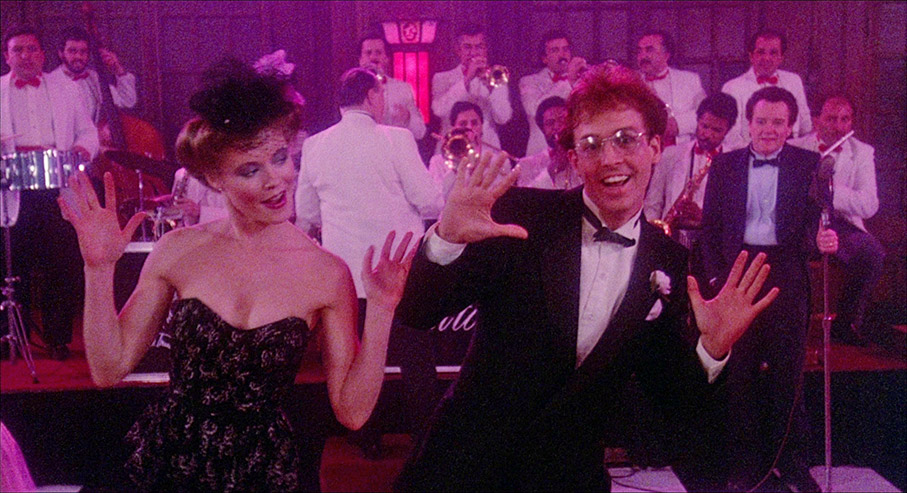
If this sounds like I’m describing the sort of fluid and complex plot that Bong Joon-ho could shape into a socially conscious masterpiece then I may need to take a small step back, as it’s hard to deny that Crimewave sometimes feels more like a series of comical vignettes than a fully formed movie. Slotting it into a specific comedy subcategory is nigh-on impossible because Raimi and his collaborators throw in everything they have, from verbal gags, black comedy, farce and slapstick to parody and satirical gameplaying with movie conventions – here anything is game and often collides in a single sequence or gag. For many, this was and will remain a problem, but for me this comedic assault is so brimming with invention that it ultimately survives all the studio meddling and the dilution of Raimi’s original vision. Is all of it laugh-out-loud funny? Absolutely not, but the best moments are priceless and there are a lot more of these than the film’s reputation – or, indeed, the Bruce Campbell quote at the top of this review – might (mis-) lead you to believe. And when they work, we’re not just talking great gags but great sequences, ones in which one gag dovetails seamlessly into the next.
A prime example of this begins when Renaldo leaves Nancy with a restaurant bill that she is unable to pay, a solution to which suddenly presents itself in the shape of a dance competition whose prize money is the exact amount that she needs. Cut straight to the competition itself and Vic and Nancy are dancing for all they are worth, suddenly aware that they are in a movie and throwing cheery and confident looks at the camera. Just a few seconds into this a whip-pan takes us to the unfortunate aftermath of the competition, in which Vic is still dancing and grinning at the camera as he gaily washes dishes, seemingly aware the competition is over and loving every second, while the utterly bemused Nancy looks on as if worriedly observing the actions of a deeply disturbed friend. There’s even a sequence end cap when the next pile of washing-up is wheeled in, perfectly framing Nancy as the weight of the evening’s disappointment really begins to crush her. Later, the film even dips its toes into the realms of the surreal in an extraordinary sequence set in the ‘Parade of Protection’, a corridor of brightly coloured display walls, doors and locks located in an improbably large room located somewhere in Trend and Oldegard’s store. As Helene moves through the doors with a ballerina’s grace, opening each one and closing it behind her in an unbroken sequence of smoothly executed bodily rotations, the pursuing Crush just barrels through them as if they were made of rice paper, only to have to then rapidly retreat as they begin to topple towards him like giant multi-coloured dominoes. As memorable for the eye-catching angles and lighting of Robert Primes’ cinematography as Gary Papierski’s art direction and use of colour, it makes little real-world sense, but is so imaginative and visually striking that this doesn't seem to matter.
Thematically, Crimewave may differ markedly from The Evil Dead, but stylistically the two are almost blood brothers, with the camera as a much a character in the film as its human counterparts. Again, Raimi’s approach varies widely here. At one end we have a long-held wide shot as the camera dollies slowly down the street during a raging storm and a succession of sometimes large-scale physical gags unfold with Buster Keaton timing, while at the other are the rapidly cut shots of the camera chasing crockery through the air as it is thrown at Crush by the panicking Helene. This second sequence climaxes when a flying vase of flowers is caught by Crush, who quickly removes the plants, smashes the vase against his forehead and holds up the bouquet with the cackle and grin of an over-enthusiastic bridesmaid at a demonic wedding. The use of extreme wides and offbeat angles, meanwhile, not only adds to the visually comic aspect of some scenes (the swift crane down from Helene’s terrified reaction to Crush’s “Lady, you ain’t seen nothing!” to the climactic bark of “Yet!” is made all the more effective by the camera move and its musical accompaniment), it also plays as something of a trial run for the similarly audacious camerawork in Raimi’s Evil Dead II and the Coen brothers’ Raising Arizona.
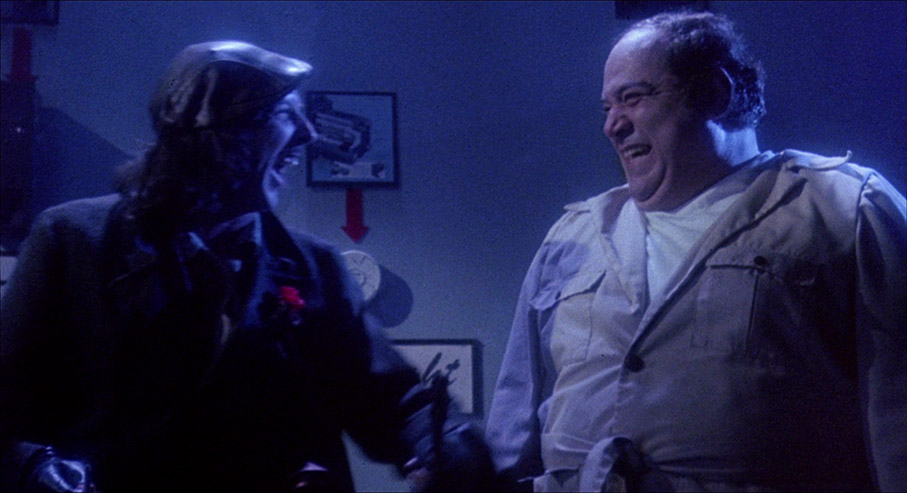
When it comes to the performers, nobody is going to get accused of underplaying, but as Kim Newman points out in the extra features, it’s Paul L. Smith and Brion James who seem most aware that they are in a live-action cartoon. The squeaky-voiced and deliberately rat-like James is almost unrecognisable as the man who played combat replicant Leon in Blade Runner three years previously, while the physically imposing Smith has been overdubbed by wrestler Dick Afflis (aka Dick the Bruiser) and delivers all his lines in a high octave gravelly growl. Both ham it up to a level that’s completely appropriate for the tone of the film, and it’s Smith who delivers one of the most peculiarly funny moments when he exits Trend’s office carrying the body of his victim in a sack. Normally this would be presented as an overly secretive action, but Crush seems highly amused by the whole thing, walking towards the camera in small, dance-like steps, his lips pursed in amusement and humming merrily like an odd-job man going about his day. Once in close-up he pauses and looks around him, barely able to contain the desire to burst out laughing, like a kid who has just set up the funniest prank of his life and is just checking to see if it is safe to unleash it on an unsuspecting world.
Top-billed Louise Lasser goes the whole nine yards as Helene Trend and is all the funnier for it, producer Edward R. Pressman is surprisingly engaging as her husband Ernest (his realisation that he has walked into a broom closet and his practice run and mocking laughter are highlights), and Sheree J. Wilson strikes just the right comic tone as Nancy, particularly when slowly driven to distraction by Vic’s relentlessly upbeat view of what may be the worst night of her life. Reed Birney may not have been Raimi’s first choice as Vic, but he makes the role his own and is every bit as invested in the film’s cartoon ethic as Smith and James, from his gloriously exaggerated hopefulness at the arrival of the Governor when facing execution (“I didn’t want to miss this”) to his overly cheery plate-washing and misguided over-confidence when standing up to Renaldo. Which brings me handily back to Bruce Campbell, and while I’d love to have seen what he would have done with a character that was written specifically for him, in the consolation role of Renaldo – despite being on screen for a total of just five minutes in sequences that mostly run for less than one minute apiece – he comes close to stealing the film. He’s sublime casting as Renaldo, oozing comically contemptuous sleaze with every glance he throws and every word he says, and this is very much down to Campbell’s performance – the line my friend and I most regularly quote at each other (“I’m not such a bad guy. Or am I?”) is not funny in itself but is made so by the delicious manner in which Campbell delivers it, just seconds before being hit with the most outrageous physical gag in the film.
It’s not just the leads who get to shine here. Even the supporting and bit-part players have been carefully chosen to make an impression in just a few short seconds of screen time: the executioner (Ralph Drischell) who greets the terrified Vic and motions him to the electric chair like a friendly waiter showing a valued customer to his table; the eccentric Colonel Rodgers (Three Stooges regular Emil Sitka), who after telling Vic about the storm-predicting properties of his cranial steel plate, pulls off one of the most complex double takes (or should that be quadruple-takes) I’ve ever seen; dance hall master of ceremonies (Jimmy Launce, a real-life radio personality of the time), whose enthusiastic and perfectly timed announcement of the dance competition feels like the real deal; balding band leader Johnny (Joseph French), whose overly cheery grin is a split-second masterclass in showbiz parody; the elderly woman whose dogs give rise to one of the film’s funniest gags and who watches on as mayhem unfolds before her with a priceless look of triumphant oneupmanship on her face; the waiter (played by Raimi’s brother Ted and looking like an especially sleazy James Remar) whose two brief shots in which he alternately laughs and shakes his head in mocking disbelief at Vic’s misadventures stayed with me so vividly that I was later convinced he had been on screen for longer; the grizzled but good-hearted veteran who lends Vic his car in the name of romance by handing him the keys and telling him gently, “She sticks a little in third.” I could go on. Oh, and if you’re quick, you’ll spot two brief appearances by a young Joel and Ethan Coen as press photographers at Vic’s impending execution, and Frances McDormand as one of the nuns rushing to save his life in the opening and closing wraparound scenes.
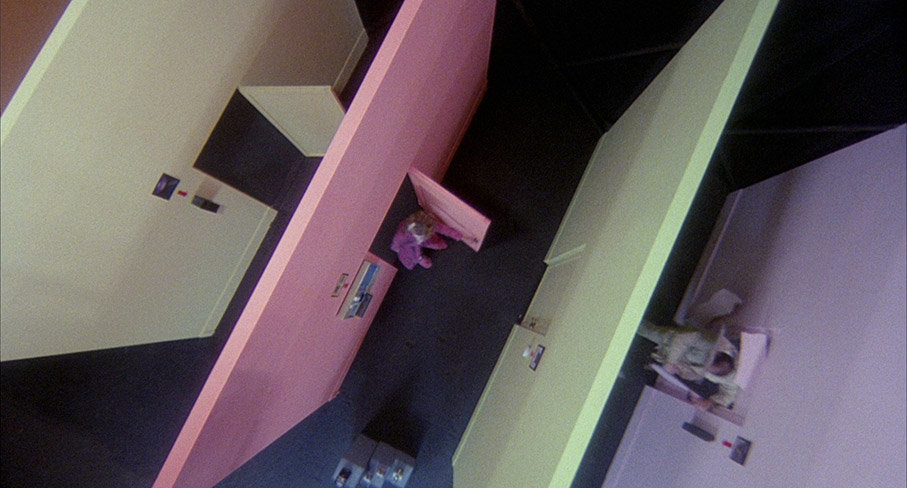
I’m aware that I may be over-selling a film that many will regard as an unfunny shambles, but Crimewave is one of those movies that we as film devotees take a liking to for reasons that are personal to us and inexplicable to others. Yes, it’s very silly and yes, its production problems have resulted in what we know is a compromised product, but it’s a testament to the talent of those involved that those of us who have taken it to our hearts can still get so much from it. It certainly proved to be a bonding work in my circle of friends, almost all of whom saw it independently of each other and hold in in the highest esteem. Given what went on behind the scenes during its making, I completely understand why seemingly everyone involved now shudders when asked about it, but while Raimi may have made more polished, successful and critically acclaimed films since, for myself and my treasured circle of friends, almost none proved to be quite as much fun as Crimewave.
Included on this Blu-ray are a generous four versions of the film, three of which are effectively the same cut with different main titles – Crimewave, The XYZ Murders and Broken Heart and Noses. All of these are the full 87-minute European cut, but also included is the 82-minute American cut, which as well as being shorter has a subtly altered soundtrack and includes one shot that is unique to this version. I’d need to watch both cuts a few more times more to accurately report on the soundtrack differences but did get both on the editing bench to do a side-by-side comparison regarding the cuts. I can’t claim that this is a definitive list, but below are the changes I was able to spot. I’ve listed them in chronological order and there are plot spoilers here (like that really matters), so newcomers should proceed with caution.
When Helene is watching the office from her apartment and realises that Oldegard is no longer alone, her husband’s response is edited differently here and includes a long-held close-up of Trend looking anxiously at his wife that is not in the European cut.
When Crush gets a fork stuck in his nose and stands up to pull it out, the editing differs slightly in this version, with the order in which a couple of shots appear altered from the European cut.
The first substantial removal of footage (32 seconds’ worth) comes when Vic and Nancy emerge from the dance hall after it closes and Nancy responds to Vic’s cheerful proclamation that this has been “some night” with a disbelieving, “Some night? It couldn’t possibly have been worse!” In this cut Nancy is then immediately hit by a splash of mud from a passing car. In the European cut, Nancy continues her complaint by listing all of the disasters that have befallen her that evening, while Vic continues to insist that things could have been a lot worse, and it’s then that car drives past them (an action not seen in the same frame as the characters in the US cut) and the splash of mud hits Nancy. The European version is definitely better here, providing a more substantial build-up to the mud-splash payoff and better justifying Nancy’s subsequent angry shouts at Vic. It’s also part of what for me is one of Sheree J. Wilson’s best comedic scenes.
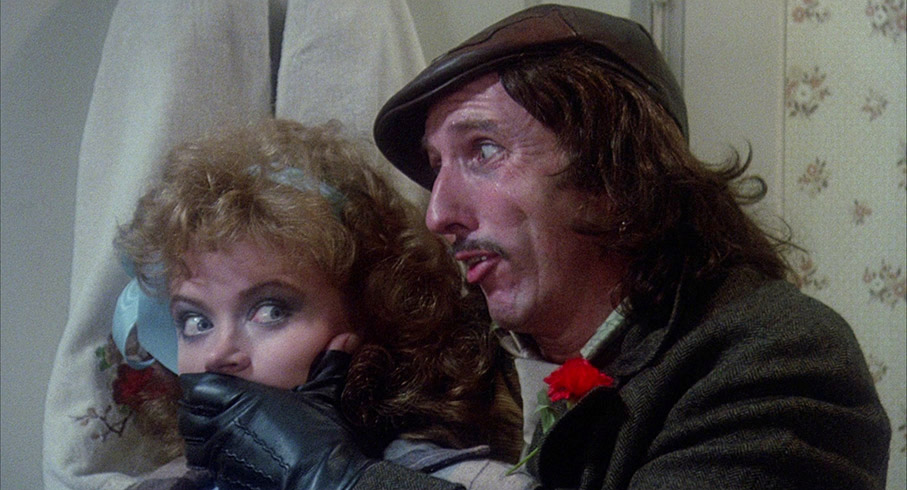
The second major cut is even more substantial and removes 3 minutes and 32 seconds of footage. This occurs when Coddish is hiding in Nancy’s apartment, after he has revealed himself to her and has dragged her into the bathroom to prevent her screaming for help. What’s missing is Vic’s return and the largely one-way conversion he has with Nancy through the bathroom door, unaware that Coddish is holding Nancy hostage and imitating her voice. Again, I have no idea why this would have been cut, especially as it’s probably Brion James’ funniest scene, as he mockingly predicts the romantic clichés that Vic will spout, then delivers a twitchily hyperactive parting speech to Nancy that showcases James’ comedy skills more effectively than his louder (though still enjoyable) Two Stooges work with Smith. This cut also removes any reference to Vic's belief that Nancy is giving him the brush-off by not replying, as well as his resulting proclamation that he never had a chance with her.
When Crush punches Vic out in the appartment hallway and calls out to Arthur that it’s every man for himself, the editing of the sequence has been altered and Coddish’s line to Nancy, “You have a rodent problem?” has been cut.
BIG SPOILER WARNING on this one. When Coddish is on top of the rat van about to crush Vic with the giant model rat, 24 seconds have been cut in which Vic warns Coddish of an approaching overpass and Coddish, after almost looking round to check, mocks Vic’s attempt to fool him and his belief in people. The European version thus provides a bigger build-up to what inevitably happens next.
Framed in its original aspect ratio of 1.85:1, this 1080p transfer from a StudioCanal HD remaster may not quite pop in the manner of a pristine restoration of a big-budget studio production, but it’s still far and away the best I’ve seen the film look. The detail, though a tad soft in a handful of shots, is for the most part very clearly defined and at its best is impressively sharp, though never artificially so. Contrast is well balanced with good shadow detail, handy given how much of the film takes place at night, and the lively use of colour in the sets and lighting is vibrantly reproduced here. For the most part, the image is also clean and free of damage and dust (very occasionally, small signs of wear make a brief appearance), and an organic film grain is visible throughout.
The DTS-HD Master Audio1.0 mono soundtrack was remastered along with the picture, and despite lacking anything much at the bass end of the audio spectrum, it’s in very good shape and sounds absolutely fine. The dialogue and all-important sound effects are always clear, and Arlon Ober’s lively and varied music score is cleanly reproduced.
Optional English subtitles for the deaf and hearing impaired are available.
Audio Commentary with Bruce Campbell and Michael Felsher
Few commentary contributors are as reliably entertaining as Bruce Campbell, and as a result I was really looking forward to this one, so rather than listen to it while I was working as I often do with commentaries, I sat down with a coffee and snacks to enjoy it to the max. It didn’t disappoint. Disc producer and filmmaker Michael Felsher (he produced and edited three of the filmed interviews on this disc) plays host but wisely takes a back seat and just lets Campbell run free, which he does in typically good-natured and energetic fashion. He talks about the early title changes, the original ambitious opening crane shot, being rejected for the lead and replaced by Reed Birney (whom he now reveals is “the toast of Broadway”), his fellow performers, the turbine wind machines used to create the storm, his role as producer and a mediator between the filmmakers and the actors, the spectacular restaurant table stunt, the dubbing of Paul L. Smith’s voice, the freeway sequence on which he was second unit director, the involvement of the Coen brothers, and so much more. There are some honest stories about the problems they had with actors Paul L. Smith and Brion James, including the latter’s drug-fuelled hotel room meltdown, plus details of a practical effect that could have taken the actor’s eyes out had it misfired, and an honest admission that they all thought they’d never make another movie after the film was finished and barely even released. I’m just scratching the surface here. A truly wonderful companion to the film that as far as I’m aware has been licenced from the American Shout Factory release.
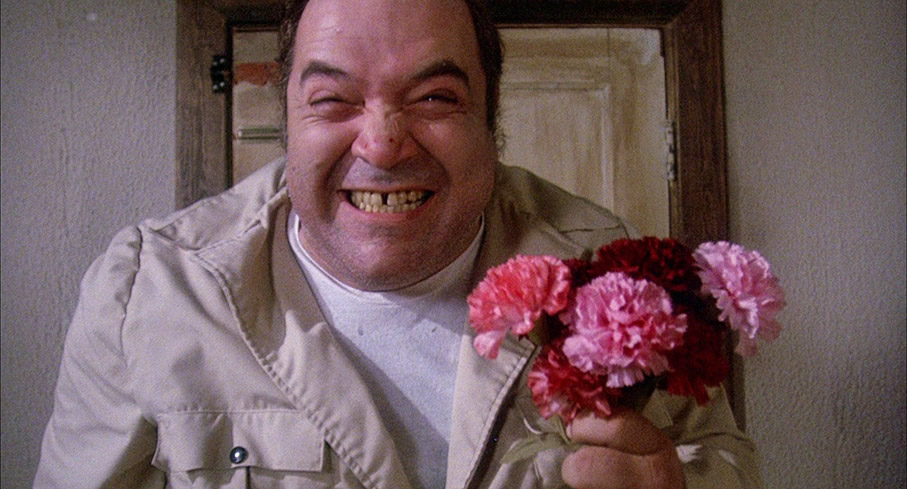
Audio Commentary with James Flower
This second commentary by writer and Blu-ray producer James Flower is an object lesson in how to approach the creation of a companion track to one that already exists. This kicks off with Flower strongly advising you to listen to Campbell’s commentary first and he then makes a point of not repeating Campbell’s words, which ensures that this track compliments the earlier one rather than overlapping it. He examines scenes in the film in relation to how they were written in the original screenplay and the nature of American film comedy at the time, quotes Sam Raimi on the issues he had with studio, provides biographical information on the key filmmakers, talks about the influence of Three Stooges, and even provides a breakdown of the Easter eggs on the newspaper that briefly slaps against the screen during the storm sequence. There’s plenty more, all of it most worthwhile. After Campbell’s commentary, this should be your next stop.
Bruce Campbell: The Crimewave Meter (15:23)
A Red Shirt Pictures production for Shout Factory, this 2013 interview with the ever-likeable Bruce Campbell does overlap a little with Campbell’s commentary track but is still most welcome and includes plenty of new and entertaining material. Here Campbell talks about how the desire on his, Raimi and Tapert's part to do something completely different from The Evil Dead gave birth to the blood-free Crimewave, how they were completely unprepared for the challenges of making a studio film, the negative feedback from the studio execs that led to them taking control of the editing, the film’s token release, and a Seattle Film Festival screening at which the audience was at least was given an appropriate introduction to what they were about to see. The title comes from Campbell’s revelation that when he is working on a film that isn’t turning out well, he calls the moment of realisation his Crimewave meter, and claims that “everyone involved shudders when they think of that movie,” a statement that is backed up by Kim Newman below.
Reed Birney: Leading Man (16:04)
A most engaging 2013 Shout Factory interview with leading man Reed Birney, who recalls his early ambitions to be an actor, his work in theatre and how he came to be cast in Crimewave, then moving on to some memories of the shoot. He clearly enjoyed working with Sam Raimi and Bruce Campbell, notes that a key scene that was cut by the studio ended up being recreated by Raimi in Spiderman 2, and reveals that he got so depressed about the time the film was taking to complete and the negative reaction to it that he moved to Paris for a year, where he ended up doing press for its French release. He nonetheless confirms that the film was a blast to do and is glad that it has developed a bit of a cult following. I should also note that it’s Birney’s opening description of the film that gave this review its title.
Edward Pressman: Made in Detroit (8:33)
The third of the 2013 Shout Factory interviews produced by Michael Felsher is with acclaimed producer Edward R. Pressman (check out the man’s impressive CV on IMDb), who looks back at his involvement in this film. He kicks off by saying that he loved Raimi’s energy and that he always tries to support the filmmaker’s vision but admits that here some things were lost in the process. He recalls first meeting Raimi at a film festival, describes Crimewave accurately as a live-action cartoon, and talks about being cast as Mr. Trend and requiring multiple takes because he couldn’t remember his lines. Revisiting the film all these years later he is impressed with its vibrant energy and original sense of humour and admits that it’s better than he remembered.
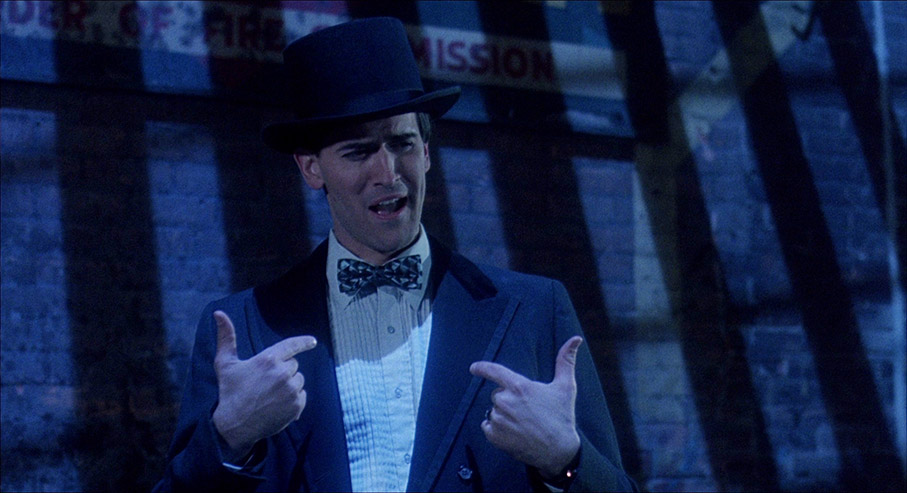
Kim Newman: Rank Outsider (9:39)
A really interesting contribution from author and critic Kim Newman, who recalls being banned from Rank Organisation screenings because of something he wrote when working for London listings and review weekly, City Limits (which I used to slavishly read, I should note), only to be invited back by a Rank representative to a screening of Crimewave “because you’re the only person who will like this film.” He comments on what he enjoyed about the movie, and while he thinks Reed Birney is fine in the lead, he does wish we were watching Bruce Campbell doing all this stuff. He suggests that the film is the most minor credit of everybody involved and recalls Raimi and Campbell shuddering when he admitted to them that he liked it, but is personally glad it’s coming out again in close to an approved version.
Bob Deering: Too Much for Comfort (7:14)
Comedian, musician and writer Rob Deering offers an enthusiastic appreciation of a film that has a strong sense of “what IS this?” running through it, highlighting some of the best sequences and the elements that are specific to the Coen brothers. He also cannily suggests that it’s easy to imagine it being someone’s favourite film.
On-set Footage (11:12)
What looks like 8mm video footage shot on set by Reed Birney and an unidentified accomplice when Birney himself is on screen. The shots of Raimi directing are a valuable grab, more so than the craft room footage of technicians eating and smiling at the camera. Birney himself claims the camera was a Christmas present, and some of the footage is shot with a fisheye lens attachment, which does distort the imagery somewhat.
Promotional Reel (13:37)
A previously unseen digest version with unique voice-over, intended for industry use and containing some alternative takes of shots used in the film, as well as a couple that were cut from the release version.
Original Trailers
US Theatrical Trailer (2:21)
Framed 4:3 and sourced from a tape original, this trailer has comically slanted narration and music, with Crush and Coddish referred to as ‘Fat Man’ and ‘Rat Man’. Includes two of the alternative/cut shots from the promotional reel.
US Home Video Trailer (2:18)
Also framed 4:3 and a little on the dark side, this trailer nicks music from Taxi Driver (for real!) and has a more traditional narration and enough spoilers to make it worth avoiding if you’ve not yet watched the film.
French Theatrical Trailer (2:07)
The French trailer under the peculiar title of Mort sur le gril, which translates as Death on the Grill. Unsurprisingly, perhaps, the actors are dubbed in French, and whoever dubbed Paul L. Smith has done a decent job of matching Dick Afflis’s original growl.
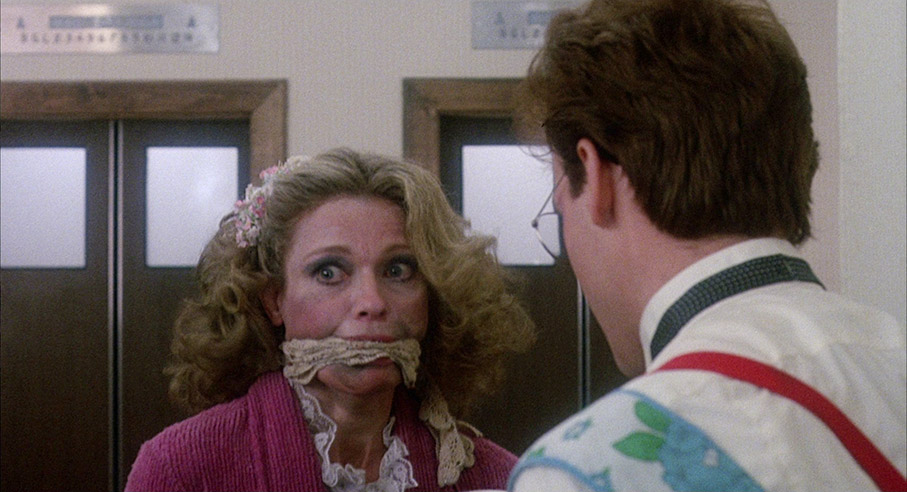
Image Galleries
Promotional Material
89 screens of promotional stills, including one from the deleted original ending, an ad posted in Variety thanking the Madrid Film Festival for awarding Sam Raimi the Best Director award for the film, video covers and posters (the Japanese ones are nuts). Many of the images were supplied by Reed Birney.
Behind the Scenes
28 screens of behind-the-scenes photos, including some of Raimi directing, all of which were again supplied by Reed Birney.
The XYZ Murders Script
Scans of the pages from the original script, spread over 47 manually navigable screens. I’d personally have preferred a PDF of this one but realise that this would be inaccessible to anyone who doesn’t have a Blu-ray drive attached to their computer. The scans are high resolution and the text is clear and is thus easy to read on an even moderately sized TV screen.
Booklet
After credits for the film, there is an essay titled The Crimewave That Broke Hearts and Noses by film historian, academic and archivist Amanda Reyes, which traces the film’s development and subsequent production problems and notes the influence of The Three Stooges on its style. She also champions the film’s qualities as art and entertainment and, like us, believes it’s a whole lot of fun. Next up are extracts from Bruce Campbell’s autobiography, If Chins Could Talk – Confessions of a B-Movie Actor – from which the quote at the top of this review is also taken and which I can heartily recommend – some of which is also covered in Campbell’s commentary track. For those who don’t know the film well enough to make direct comparisons with the ‘Final Draft’ screenplay included as an extra on this disc, senior disc producer at Arrow Films, James Flowers, then highlights many of the key differences between this script and the final film, as well as speculating on what might have been had the changes not been enforced. Up next is an interesting piece comprised of extracts from interviews in which Reed Birney, Brion James and Sam Raimi look back at the film and, as you might expect by now, Raimi remains deeply unhappy with the way things went. “I can’t look at it,” he told Empire’s Christ Hewitt in 2009. “It’s so painful. The experience was just awful.” Finally, we have extracts from contemporary critical reviews, which prove not to be as hostile as I was expecting. As ever, the booklet is illustrated with promotional imagery.
Some will love it, others will hate it, many will find themselves not bothered either way. Crimewave is the very essence of cult cinema, a film effectively disowned by its director, whose original vision was completely scuppered by studio interference but which has found a loyal and enthusiastic fanbase nonetheless, of which I am unashamedly a member. The news that it was going to be released on Blu-ray in the UK by Indicator had me more excited than is probably logical, but the disc proved to be everything I was hoping for, with a strong transfer, two excellent commentaries and a slew of worthwhile supporting material. Feel free to dislike the film, I won’t care a hoot, as it’s still a personal favourite, and this disc does it proud. For those prepared to wear their silly hats to watch and enjoy it, this has to come most highly recommended.
|